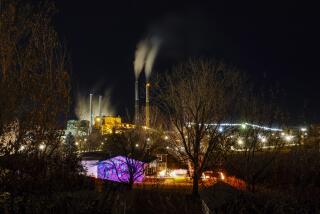Women Get Shaky Equal Opportunity in Mines
CHARLESTON, W. Va. â It took the women of Appalachia a couple of centuries to be allowed to go into the mines and dig coal alongside their men, earning some decent money.
Now, with mechanization forcing the layoffs of coal miners even as production increases, their ranks are thinning. They are usually the first to go because they lack seniority.
Thatâs a threat to women like Libby Lindsay, a coal minerâs daughter whose father repeatedly warned her that âthe mine would fall in if a woman went in.â
It didnât. Lindsay was among the industryâs first female coal miners when she entered the Eagle Nest mine, about 40 miles southeast of Charleston, in 1976.
âI wasnât afraid to go underground, but I was afraid I wouldnât be able to do the work,â Lindsay recalls. âI promised myself if I couldnât do the work, I would quit. But that wasnât a problem.
âIâve never seen another job Iâd trade for.â
But the last decade has been hard in the coal mines and even harder on the few women who got their feet in the portals.
As coal production rose 27% from 1981 to 1990, the number of miners dropped 42%, to 131,306, as the industry was mechanized, according to the National Coal Assn.
More than half of the 3,800 women hired since 1973 have been laid off, according to the federal government, which has been keeping records since women first won the right to work at one of the most dangerous jobs through the Equal Employment Opportunity Act of 1972.
The number of women being hired peaked around 1978 or 1979, according to Marat Moore of Washington, D.C., who is collecting an oral history of women in the mines.
Moore, a former coal miner herself, said females had been stereotyped and those who wanted to muscle in on traditional male jobs were considered odd.
âItâs not just that these are a different breed of women,â she said. âTheyâre women who are trying to earn enough money for a pension, to send their children to college.â
Women in Appalachiaâs coal communities were expected to stay home, raise children and tend a garden, said Ron Lewis, a history professor at West Virginia University.
If a woman needed to work, the only jobs available were at the company store, he said.
âThose women who lived in the coal fields had few opportunities to get a good job,â he said. âIf they did get a good job, it was going to be in the mines.â
Women worked in coal mines as far back as the Middle Ages in the British Isles, he said.
âIt gradually became a totally male occupation,â he said. âMen saw getting women out of the mine as progress because it was debilitating work. Itâs hard to be down in the mines and raise the children. If the men were in the fields and the women were in the mines, who was taking care of the children.
âNow there are schools for the children to attend and day-care programs so these things can be taken care of.â
Lindsay, 35, has worked all of the jobs in coal mines, from bolting the roof of mines for safety to running the unforgiving machines that rip coal from sheer black walls. She said she is accepted by her fellow miners and comes to the surface as gritty as the rest.
It doesnât bother her. She remembers her father coming home every day thickly coated in coal dust too.
âAll youâd see were the whites of his eyes and a spot on his mouth where he spit tobacco all day trying to keep the dust off,â she said. âIâd meet him at the door with a wet cloth and wipe off a place to kiss him.â
Lindsay, who is active in the United Mine Workers, usually earns nearly $17 an hour. She is not married and has no children.
âThe first thing the superintendent ever said to me was, âGod, I hate to see yâ Lindsay said.
âI think they hired me because I was young, 18, and they thought Iâd work a few years and then quit to get married.â
Lindsay said she just wanted to be like her father, who was a miner for 32 years. But she also worries she will inherit his legacy of illness. He had to leave the mines in 1972 because he developed black lung, a debilitating disease caused by the inhalation of excessive coal dust.
âI worry about black lung more than I ever did,â Lindsay said. âI donât worry near as much about coal dust as the rock dust. When they cut that rock, a big white cloud just hangs there and chokes you to death.â
Still, coal mining is âpretty much the only thing there is in this region unless you want to wait tables,â Lindsay said.
âI worked in a store one Christmas vacation and I hated that,â she said. âThey stood over you all day like you were going to steal something. When it was over, I swore Iâd never go to work in a job where I have to be nice to people who are yucky.â
Eleven years ago, Bonnie Boyer also was working in a department store in Harrisburg, Pa., when she saw a newspaper advertisement that Coal Junction Coal Co. in Shelocta, Pa., was hiring.
She wanted to earn more than minimum wage. She didnât think about whether she would like working underground with no other women.
âThereâs no way for me as a person without a degree to really make the type of living that I can make in the mines,â she said. âIf I didnât want to live in poverty in the jobs they call womenâs jobs I had to go outside to survive.
âAt first it was a little strange and a little uncomfortable, but now it doesnât bother me at all. At first they treated you differently, but now Iâm just one of the guys. They still tease me, but I tease them back.â
Boyer said she also took some lumps from coal minersâ wives.
âAt first it was awful,â she said. âThey shunned you and would walk away from you. It took a while to get them to realize I was just there for the job and not after their men.â
Boyer, 34, said in the early days she saw men she trained get promoted ahead of her.
âBut you go through that in many jobs,â she said.
Boyer, who drives a shuttle car back and forth to the end of the tunnels, said women and men face the same dangers.
âThe mine industry is a dangerous, dangerous job. Anyone who puts 10 years in and doesnât come out with an injury is very, very lucky,â she said.
Since 1978, six women have been killed in the coal mines, according to a spokesman of the U.S. Mine Safety and Health Administration.
United Mine Workers President Richard Trumka said women are treated equally in the mines.
âIn America right now, women still only earn 66% what men do,â he said. âThatâs not true with us because of the union. In the rest of America, one of every three working women earns poverty wages.â
Women have always been important to the union, Trumka said.
âTheyâve always been very active in organization and strikes, even though the work force was for many years almost exclusively male.â
More to Read
Sign up for Essential California
The most important California stories and recommendations in your inbox every morning.
You may occasionally receive promotional content from the Los Angeles Times.










